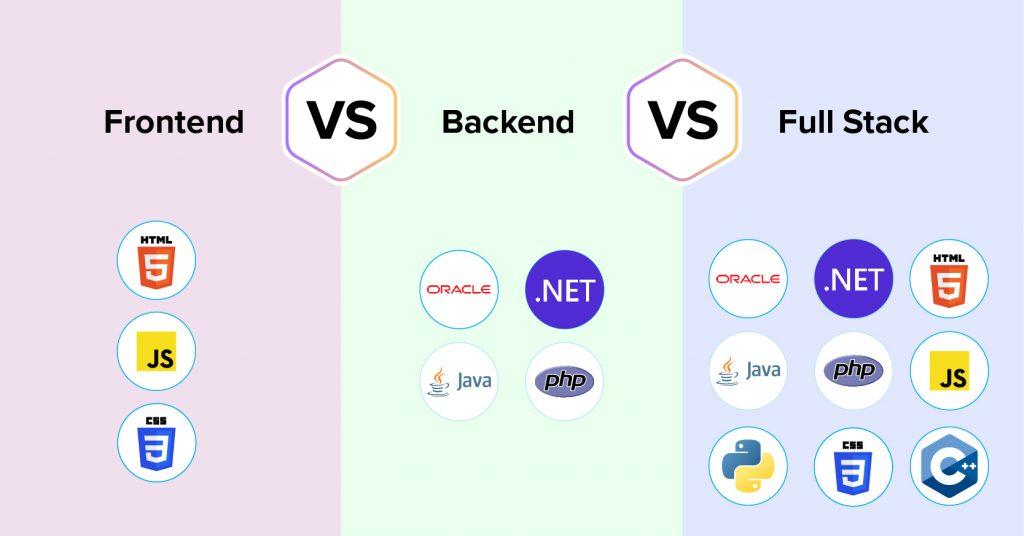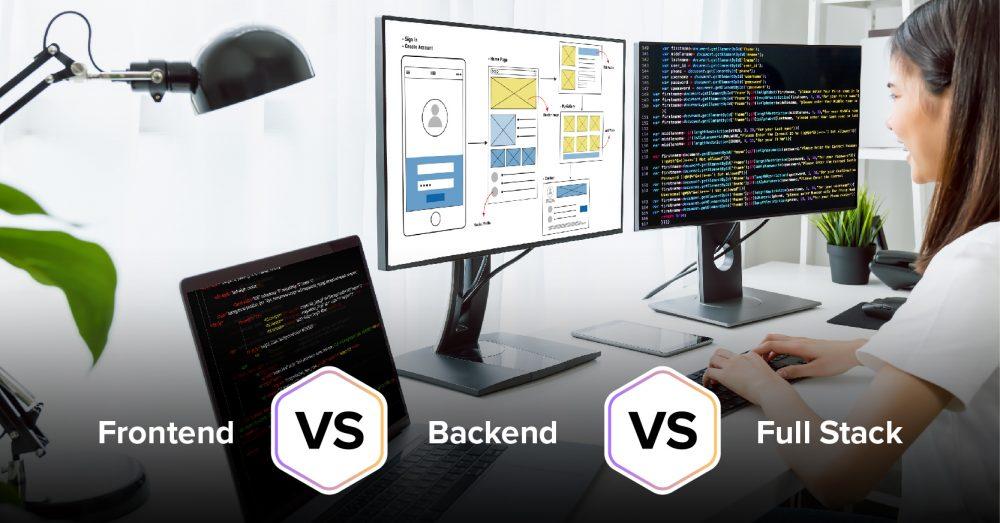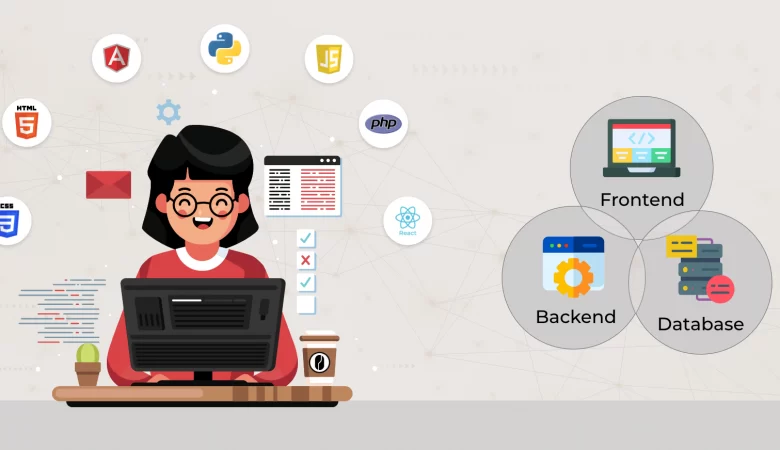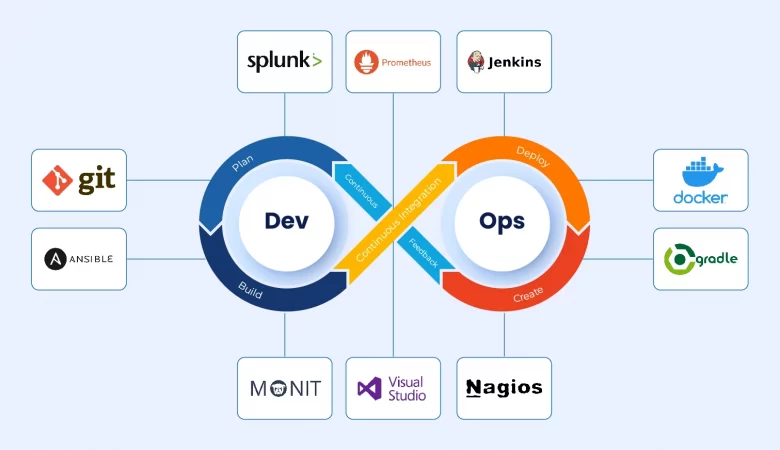To start with, we all will agree on how webpages have undergone a remarkable transformation over the past decade and so.
The journey of web development has been a fascinating one, marked by technological leaps and paradigm shifts.
From static, text-based pages to dynamic, multimedia-rich experiences, the web has come a long way, and at the heart of this evolution lies under the three crucial domains:
Front End, Back End, and Full Stack Development. Each of these domains represents a distinct aspect of web development, contributing to the creation of websites as well as feature rich applications.
Today, let us unravel the intricacies of these integral facets of web development.
We will dive deep into what makes each domain unique, exploring their defining features, and gaining insights into the essential skills required for success.

Table of Contents
What Is Front End Development?
Front-end development, commonly known as the “client-side,” involves shaping the user interface and experience of a website or web application.
In fact, Front End Development involves crafting the elements that users see and interact with directly.
For instance, think of a restaurant website. The Front End Developer is totally responsible for designing the menu layout, thereby ensuring that the colors, fonts, and other design elements are visually appealing.
Also, it involves creating interactive features like online reservations.
Assume – when a user visits the website and clicks on a dish, the front-end code instantly displays an image and details about the dish, making the user’s experience not just informative but also appealing.
In essence, Front End Development is the artistic and user-focused side of web development, where aesthetics meet functionality.
Features Of Frontend Development
The attributes of front-end development are instrumental in molding the digital landscape.
They encompass various aspects, from visual appeal to performance optimization, all contributing to an enhanced user experience and broader accessibility.
(i) User Interface Design:
Basically, UI design involves crafting visually appealing and user-friendly layouts for websites and applications.
It entails careful choices in colors, fonts, and graphical elements to ensure a seamless user journey.
A well-crafted UI not only attracts users but also guides them effortlessly, thereby leading to more engagement and usability.
(ii) Responsive Design:
No doubt, we all will agree that responsive design is indispensable.
It ensures that the websites and apps adapt gracefully to diverse screen sizes and devices, offering a consistent and enjoyable user experience.
By implementing responsive techniques, you ensure accessibility and heightened user satisfaction, regardless of how end users access your website’s content.
(iii) Interactivity And User Experience:
Interactivity and UX are significant in maintaining user engagement and satisfaction.
It is seen that the inclusion of interactive elements like multiple buttons and animations encourages more user involvement.
Indeed, a positive UX guarantees easy navigation, readily accessible content, and frustration-free task completion, resulting in increased user retention and conversion rates.
(iv) Accessibility And Inclusivity:
Accessibility is by far one of the most fundamental things in Front End Development.
It ensures that the digital products cater to a diverse audience, including those with unfortunate disabilities.
By adhering to accessibility guidelines, you create an environment where everyone can access & engage with your website, thereby creating social responsibility and broadening your user base.
(v) Performance Optimization:
Front End Developers optimize the performance of websites and apps by minimizing loading times It encompasses image optimization, code minimization, and the utilization of content delivery networks.
A fast and efficient platform not only enhances user satisfaction but also positively impacts search engine rankings and conversion rates.
What Are Front End Developer Skills?
Front End Developers possess a diverse skill set that empowers them to shape the users they interact with. These skills include:
1. Knowledge In JavaScript:
Front End Developers must possess a strong command of JavaScript, a versatile and essential scripting language.
It enables them to create dynamic and interactive web pages, enhance user experiences, and connect with Back End functionalities.
2. jQuery Knowledge:
jQuery is a JavaScript library that simplifies DOM manipulation and event handling.
Familiarity with jQuery can speed up development to a much greater extent and enhance interactive features.
3. An Upper Hand In HTML:
Certainly, it goes without saying that HTML (Hypertext Markup Language) serves as the bedrock of web development.
Front End Developers must possess a clear understanding of HTML to organize content effectively.
Also, establish a semantic and inclusive basis for their designs.
4. Expertise In Cascading Style Sheets:
CSS is the backbone of web styling. Front End Developers should be skilled in CSS to control the layout, design, and formatting of website content.
Ensuring a visually pleasing and consistent appearance across different network devices and browsers (Chrome, Mozilla, Edge, Safari, etc).
5. Use Of CSS Preprocessors:
Front-end developers often use CSS preprocessors like Sass or Less to streamline CSS programming.
These tools offer variables, functions, and nesting, making CSS development more efficient and maintainable.
6. Grasp of Front End Frameworks & Libraries:
Familiarity with well-recognized front-end frameworks and libraries like React, Angular, or Vue.js holds significant importance.
These resources streamline the entire development process, enhance code structuring, and empower the development of high performing web applications.
7. Software Testing Proficiency:
Thorough testing ensures that web applications are bug-free and perform optimally.
Front End Developers should be adept at testing techniques and tools to maintain high quality code.
8. Be Skillful In Responsive Web Design:
As mentioned in the previous section too, responsive web design is essential for creating websites that adapt seamlessly to different screen sizes.
Front End Developers should excel in responsive design techniques to provide users with a consistent and accessible experience.
What Is Back End Development?
Back End Development, often referred to as server-side development, forms the intricate machinery that powers websites and web applications.
Unlike its counterpart, Front End Development, which primarily deals with creating the user interface, Back End Development operates behind the scenes, managing the hidden complexities that drive the entire system.
Imagine an e-commerce platform – As stated above, Front End Developers craft what users interact with on the website – such as product listings, the checkout process, etc.
It is the Back End Developers who makes sure that, when you add any product/item to your cart, it is securely stored, your payment is processed, and most importantly your order is promptly fulfilled.
Nevertheless, when it comes to Back End Development, databases, servers, and application logic seamlessly converge to deliver functionality, data storage, and smooth interactions.
Unfortunately, while their contributions often go unnoticed by end users, they play a critical role in ensuring the performance, security, and functionality of websites and apps.
Features Of Backend Development
Back End Development encompasses a set of vital features that power the core functionality of web applications.
These features collectively form the robust foundation that ensures the reliability, security, and performance of digital systems.
(i) Data Management And Storage:
Back End Development entails efficient data management and storage.
It involves designing, storing and retrieving data securely, thereby ensuring data integrity.
In fact, Back End developers enable applications to work with vast amounts of data sets, providing a solid foundation for information-driven processes.
(ii) Server-Side Logic And Processing:
Back End Developers create the algorithms and functions that drive the core functionality of web applications.
This includes handling a number of complex calculations, data manipulation, and organizing interactions between various components.
(iii) User Authentication And Authorization:
Back End Developers tasks involve implementing user login systems, ensuring that only authorized users access specific resources or perform certain actions.
They manage user accounts, roles, and permissions – safeguarding data and functionality from unauthorized access.
(iv) APIs And Integration:
APIs (Application Programming Interfaces) and integration are central to backend development.
In fact, Back End Developers build APIs that allow different software systems to communicate and share data.
This enables the integration of third-party services, connecting applications to a broader ecosystem of tools and functionalities.
(v) Scalability, Load Balancing, And Performance:
Backend developers are responsible for ensuring that applications can handle increased loads and maintain optimal performance.
They design scalable architectures, implement load balancing techniques to distribute incoming traffic, and optimize code and infrastructure to deliver blazing fast response times even under heavy usage.
What Are Back End Developer Skills?
Back-end developers possess a unique skill set that drives the server-side operations of web applications.
These skills encompass programming languages, database management, server expertise, version control with Git, and more. Let’s explore each of these areas below.
1. Programming Languages Proficiency:
Adhering to industry norms, back-end developers are expected to demonstrate mastery in programming languages like Java, Python, Ruby on Rails, and PHP.
Essentially, these languages serve as the foundational tools for crafting server-side applications and efficiently handling data.
2. Database Management:
In-depth knowledge of database systems is of utmost importance. Back-end developers must excel at managing diverse databases, including MySQL, SQL, MongoDB, etc.
Moreover, these databases enable efficient data storage and retrieval, making them a fundamental necessity for successful back-end development.
3. Server Management:
Familiarity with server configurations and management is by far the most essential thing.
Back-end developers need to understand server environments, ensuring that the applications run smoothly and securely.
To sum up, knowledge of server infrastructure and maintenance is invaluable in today’s scenario.
4. Version Control With Git:
Utilizing Git for version control and fostering collaboration is integral to software development.
Back-end developers are expected to be proficient in Git, enabling them to monitor code modifications, oversee code repositories, and engage in productive teamwork with their peers.
5. Data Structures And Algorithms (DSA):
Any day, a robust grasp of data structures and algorithms is imperative for back-end developers.
This expertise empowers them to enhance the overall code efficiency, boost application performance, and adeptly tackle intricate problem-solving.
This ensures the successful execution of back-end development tasks.
6. Integration With Front End Technology:
It has been seen in the past that back-end developers are expected to possess a foundational knowledge of front-end technologies, including HTML, CSS, and JavaScript.
This proficiency enables fluid communication and integration between the front-end and back-end elements of web applications.
Recommended Reading
What Is Full Stack Development?
Basically, Full Stack Development represents a holistic proficiency in both front-end and back-end development.
They possess the capabilities not only to shape the UI & UX but also to manage server-side operations, databases, and entire back-end activities.
Consider an e-commerce platform as an example. A Full Stack Developer is entrusted with the entire spectrum of tasks, from designing the user-friendly interface to adding visually appealing elements.
However, their expertise extends further, allowing them to optimize data storage, manage server environments, and handle the complexities of databases effectively.
In this way, Full Stack Development represents the fusion of artistic and technical aspects, where aesthetics harmonize with the machinery that drives web applications.
It’s a role that demands versatility and a deep understanding of both frontend and backend technologies.
Features Of Full Stack Development
Full Stack Development represents an across-the-board approach to web development, combining the activities of both Front End Development and Back End Development.
This includes, end-to-end capabilities, cross-functional expertise, simplified project management, etc.
(i) End-to-End Development:
Full Stack Development encompasses end-to-end development, from designing the user interface to managing server-side operations.
This leads to a seamless transition from concept to the final product launch.
In fact, this approach helps reduce the need for multiple specialists and streamline the entire development process.
(ii) Cross-Functional Expertise:
Basically, it is seen that Full Stack Developers possess cross-functional expertise.
They can bridge the gap between different development areas, facilitating effective communication and collaboration between both the front-end and back-end development teams.
This proficiency results in cohesive and integrated web applications.
(iii) Rapid Prototyping and Iteration:
No doubt, Full Stack Developers excel at rapid prototyping and iteration.
They can quickly build and test prototypes at a much rapid pace, enabling faster development cycles and more efficient problem-solving.
This agility is crucial in meeting evolving user needs and market urgency.
(iv) Simplified Project Management:
Full Stack Development is all about handling projects more efficiently.
With a broad skill set, Full Stack Developers can take on various project management roles, from planning and coding to deployment and maintenance.
Overall, one can say that this simplifies project coordination and minimizes dependencies on a larger workforce.
(v) Cost-Effective Development:
Full Stack often focuses on cost-effective development.
Hiring a Full Stack developer means getting a single professional capable of handling both front-end and back-end tasks, reducing the need for separate staff.
This can result in hefty cost savings and streamlined project budgets, making it an attractive choice for businesses of various sizes.
What Are Full Stack Developer Skills?
Full Stack Developers possess a diverse skill set that enables them to handle all aspects of web development.
From coding and databases to version control and design fundamentals, these professionals are actually well prepared to take projects from concept to final deployment.
Below are some of the skills that a Full Stack Developer should be aware of.
1. Development Languages:
Full Stack Developers are highly skilled in various programming languages, like JavaScript, Python, & Ruby.
Their expertise equips them to tackle both front-end and back-end development tasks, ensuring hassle-free integration between different aspects of web development.
2. Databases:
Mastery of various databases is by far the most essential skill for Full Stack Developers.
With this knowledge, they can efficiently manage data with databases like MySQL, SQL, MongoDB, and others, ensuring that the data is stored and retrieved optimally.
3. Version Control:
Full Stack Developers are adept at version control, employing tools like Git to monitor code alterations, facilitate productive collaboration, and maintain organized code repositories.
This competence is pivotal for efficient project management. Furthermore, this ensures a well-organized progression of all the development tasks.
4. DevOps:
DevOps principles are an integral part of a Full Stack Developer’s skill set.
They grasp the essential synergy between development and operations, allowing them to streamline deployment procedures.
Bolster system reliability, and effectively oversee infrastructure management.
5. HTTP and REST:
Full Stack Developers possess an in-depth grasp of HTTP and REST principles, which play a fundamental role in web communication.
This expertise empowers them to construct efficient and scalable web services and APIs, ensuring seamless interactions within web applications.
6. NPM:
Full Stack Developers are proficient in employing package management tools such as NPM (Node Package Manager).
This facilitates the efficient administration of project dependencies and the smooth integration of external packages, streamlining the development process.
7. Fundamentals of Design:
An understanding of design fundamentals is crucial for any web developer.
When it comes to Full Stack Development, it becomes really important.
It enables Full Stack Developers to create user-friendly interfaces, ensuring that the front-end elements of web applications are not only functional but also aesthetically pleasing.
Back End vs. Front End vs. Full Stack Development:
| Aspect | Back-end Development | Front-end Development | Full Stack Development |
| Responsibilities | Manages server-side operations, databases, and server configurations. | Shapes the user interface and experience of a website or web application. | Handles both front-end and back-end development tasks, thereby bridging the gap between the UI and server-side operations. |
| Skills | Proficiency in programming languages like Java, Python, Ruby on Rails, PHP, database management, etc. | Strong knowledge of HTML, CSS, JavaScript, and in-depth design principles. | Versatile expertise in programming languages, database management, version control, DevOps, HTTP, REST, NPM, and design fundamentals. |
| Project Management | Specialized in server-side tasks, often involving collaborating with front-end developers. | Focuses on the user interface and interacts with back-end developers for data integration. | Fully capable of managing the entire development process, from design to complete deployment. |
| User Experience | Less involved in user-facing elements but ensures data processing and app functionality. | Primarily concerned with creating visually appealing and stunning user interfaces. | Balances functionality and aesthetics to enhance the overall end user experience. |
| Communication | Collaborates closely with front-end developers for data integration and seamless functionality. | Collaborates with back-end developers to ensure data is accessed and displayed correctly. | Possesses cross-functional expertise to foster effective communication between front-end and back-end colleagues. |
| Example | Ensures a secure and efficient e-commerce checkout process. | Designs an engaging and user-friendly online shopping interface. | Manages an entire e-commerce platform, from the menu layout to data storage and checkout functionality. |
Wrapping Up
In our journey throughout this blog, we have literally uncovered the roles played by Back-end, Front-end, and Full Stack Developers.
Each of these respective roles represents a vital piece in the complex mosaic of crafting eye-pleasing web applications.
We have looked into the diverse skills that set these professionals apart, from programming languages & database management to design fundamentals and DevOps.
Their expertise enables them to efficiently manage projects, enhance user experiences, & communicate effectively.
Whether you are specialized in one domain or take on the all-encompassing role of a Full Stack Developer,
it is pretty much clear that the success of web development hinges on a symbiotic relationship between these roles.
Nevertheless, as the digital world continues to expand, understanding the unique contributions of Back-end, Front-end, and Full Stack Development is the key to formulating outstanding web experiences that cater to the needs of end users worldwide. Hope this was useful!









Leave a Reply